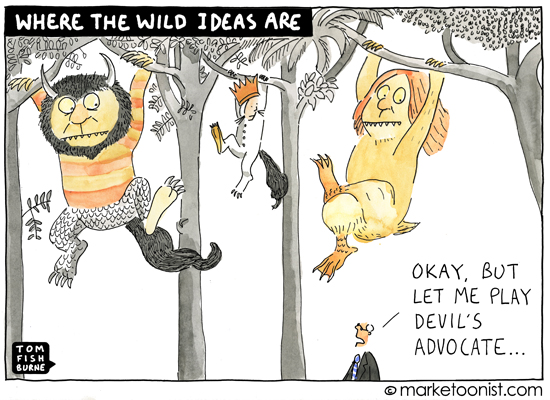Article
9 Brainstorming Techniques for Creative Business Writing
9 Brainstorming Techniques for Creative Business Writing
 Brainstorming is a crucial aspect of any creative process, whether you’re writing copy or creating a new product. Although the original definition of a brainstorm is a collaboration of ideas, the term has since become a colloquial that means any sort of creative planning, whether it’s done in a group or independently.
Brainstorming is a crucial aspect of any creative process, whether you’re writing copy or creating a new product. Although the original definition of a brainstorm is a collaboration of ideas, the term has since become a colloquial that means any sort of creative planning, whether it’s done in a group or independently.
The main goal of any copywriting brainstorming session is to come up with a successful idea that suits your particular business needs. You don’t have to be an expert copywriter (or even a writer at all) to come up with creative solutions to your marketing dilemmas–you just need to follow the basic techniques of brainstorming.
Know Your Purpose and Set Goals
Before you can even begin brainstorming any ideas, you have to figure out what you want to accomplish from your business writing. Are you trying to promote a new product or service? Do you want to try and attract a certain type of customer? Know what you want to accomplish so that your ideas will better work towards reaching your goals.
You’re not going to come out of a brainstorming session with a fully realized concept complete with copy and media–but that’s not the point. The point is to come up with a number of smart ideas which you can later build upon.
Freethinking Brainstorm Map
During the freethinking stage, let your mind wander and come up with as many ideas, words and stray thoughts related to your brand as you can think of. (Just make sure you’ve got plenty of writing space.)
Freethinking and Pre-Planning
 Even if the bulk majority of your brainstorming is going to happen during a group meeting, you still need to come to that meeting already prepared with some ideas ready to go. The pre-planning phase is just as important; in this part of the brainstorming process, it’s all about you.
Even if the bulk majority of your brainstorming is going to happen during a group meeting, you still need to come to that meeting already prepared with some ideas ready to go. The pre-planning phase is just as important; in this part of the brainstorming process, it’s all about you.
During the freethinking stage, let your mind wander and come up with as many ideas, words and stray thoughts related to your brand as you can think of. (Just make sure you’ve got plenty of writing space.) Photo Credit: Ducttapeavenger
Use Your Senses
When you talk about a product or service in your copy, you’re not just trying to hand out information– you’re trying to produce an emotional response. One of the best ways to do this is to use sensory imagery in your copywriting. We all know that Brand X is the most powerful product of its kind-but how does it smell? How does it feel? Can you hear it, and if so, what does it sound like?
Make a list of all the sensory aspects of your product or service to find words and phrases that invoke a particular emotional response. Applying a sensory technique to copywriting will allow you to look at your product or service in a completely new light.
Separate Ideas
 When you discover a good, strong concept to tie to your business writing, write it down on a notecard or slip of paper. When you discover another concept, give that idea its own notecard. If you have a good idea that’s actually two concepts combined into one, separate these ideas and put them on their own notecards. At the end of the process, you’ll have a number of different usable copy aspects that you can now mix and match to come up with something even better, much like refrigerator magnet poetry.
When you discover a good, strong concept to tie to your business writing, write it down on a notecard or slip of paper. When you discover another concept, give that idea its own notecard. If you have a good idea that’s actually two concepts combined into one, separate these ideas and put them on their own notecards. At the end of the process, you’ll have a number of different usable copy aspects that you can now mix and match to come up with something even better, much like refrigerator magnet poetry.
Post-Its or notecards allow you to organize, mix, and match your various writing ideas. Photo Credit: Sonson
Allow Wild Ideas to Develop
You have to be willing to let wild ideas develop on their own, whether you’re coming up with ideas by yourself or brainstorming with a group. In order for creativity to thrive, it must be given room to breathe, which won’t happen if ideas are constantly being rejected. Even your weirdest, craziest and downright ludicrous ideas have a place in the brainstorming process. These ideas may never come to fruition, but they may provide the groundwork for an even better idea in the future.

You have to be willing to let your ideas run wild during the brainstorming session, which means saving criticism for later. Photo Credit: Tom Fishburne
Criticism Comes Later
Not only should ideas be left to run wild during the brainstorming phase, but criticism should be left out of the equation entirely. This means both rejecting the ideas that you don’t like and trying to change good ideas that others have come up with in an effort to improve them. Brainstorming is about getting your rough ideas out there; taking time to tweak and change every idea is counter to what you want to accomplish. You should wait until the brainstorming session is finished and then go back to figure out what needs tweaking.
Set a Time Limit
 The easiest way to know when the brainstorming session has ended is to set a strict time limit. Putting the pressure of the clock on you makes you more likely to come up with rapid-fire ideas and less likely to stop and critique ideas. That doesn’t mean you should give up on finding the right idea if it doesn’t come to you in X amount of minutes–don’t forget that you can always come back to brainstorming after everyone’s had a chance to rethink and regroup. Setting a time limit just keeps you on task and helps you know when to stop brainstorming and start developing and critiquing ideas.
The easiest way to know when the brainstorming session has ended is to set a strict time limit. Putting the pressure of the clock on you makes you more likely to come up with rapid-fire ideas and less likely to stop and critique ideas. That doesn’t mean you should give up on finding the right idea if it doesn’t come to you in X amount of minutes–don’t forget that you can always come back to brainstorming after everyone’s had a chance to rethink and regroup. Setting a time limit just keeps you on task and helps you know when to stop brainstorming and start developing and critiquing ideas.
By setting a time limit, you will be able to come up with ideas more efficiently and will waste less time analyzing and second-guessing ideas. Photo Credit: Lynda Giddens
Get Others Involved
Business writing brainstorm sessions do not have to be exclusive to copywriters–they should involve anyone who can provide valuable input. Graphic designers are good to include because chances are your copy will need a graphic representation to tie it all together. Your social media staff and sales department are the ones who interact with customers on a daily basis, so they can offer a unique perspective on what customers are looking for. Hearing different ideas and input will open the door to new solutions and creative ideas that will bring out the best in your writing.
Save Rejected Ideas
You can often only pick one idea in the end, which means a lot of great concepts end up going unused. Save these unused ideas–you never know when they might be put to use at a later time or when they might serve as inspiration for another great idea. However, this doesn’t mean you should always rely on your old ideas to be successful. When a new brainstorming session begins, pick some of the best ideas from the last session to get the ball rolling, but focus on coming up with something new. If an old idea really is the best choice, you’ll discover it once you sit down to look at your ideas in closer detail.
These are just a few of the thousands of different techniques that you can use to brainstorm creative copywriting ideas, so find what works best for you. Maybe you find your team works best under pressure of a deadline or that it takes a little pizza to get everyone in a creative mood. The end goal is to create valuable copy that attracts customers to your business–however you get there is entirely up to you.
Article is from www.printwand.com.
Comments Closed.
